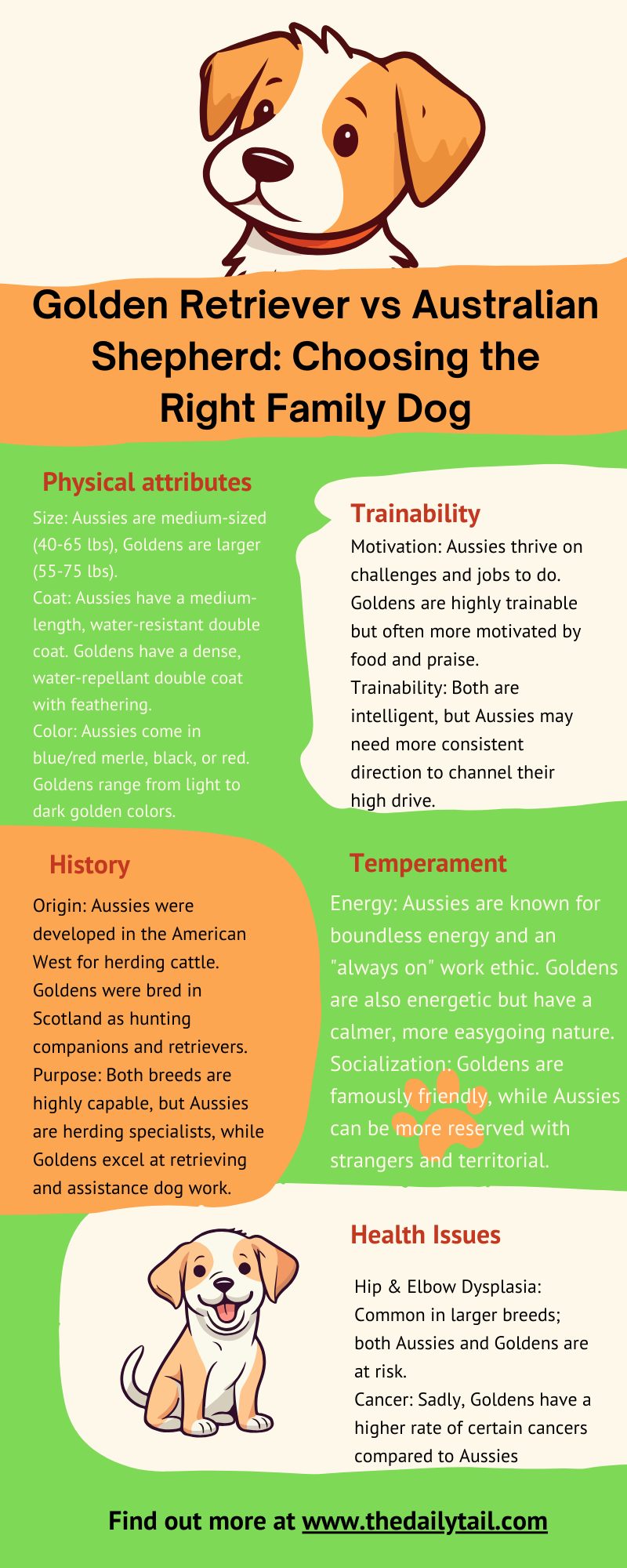When comparing the Golden Retriever vs Australian Shepherd, potential dog owners may find themselves contemplating which breed better aligns with their lifestyle. The Golden Retriever stands out with its amicable demeanor, making it a top pick for families, especially those with children or other pets. Known for being friendly and reliably trainable, these dogs typically thrive in a variety of home environments and are celebrated for their devotion to their human companions.
On the opposite spectrum, the Australian Shepherd dog breed offers a different, yet equally compelling set of traits. While Australian Shepherds are also capable of forming strong family bonds and flourish in a home setting, they bring to the table a high energy level and a need for mental stimulation and physical activity. This breed is often characterized by its intelligence, agility, and a tendency to be protective, making them a fit for those who lead an active lifestyle and can provide ample engagement.
Both breeds have demonstrated capabilities as excellent companions; however, their distinctions lie in their suitability to different owner experiences. Golden Retrievers typically require more grooming due to their longer fur, while Australian Shepherds are often praised for their robust health and longer lifespan.
The decision between the two breeds may ultimately hinge on an individual’s personal preferences and willingness to meet the distinct needs of each breed.
After a lifetime loving dogs, I understand why Aussies and Goldens top popularity charts. But which one is truly right for you? Let’s dive in! They’re both smart, athletic, and undeniably beautiful, but there’s a world of difference between an Australian Shepherd and a Golden Retriever. As a lifelong dog lover, let me guide you through it.
Breed Origins and History
The Golden Retriever and the Australian Shepherd stand out for their well-documented origins. These breeds were shaped by their environments and the needs of the people, leading to their roles as working dogs, excelling in hunting and herding, respectively.
Golden Retriever Origins
The Golden Retriever breed was developed in the mid-19th century in Scotland. Dudley Marjoribanks, known as Lord Tweedmouth, aimed to create a dog that was adept at retrieving birds from both land and water. This was a response to the inadequacy of existing retrievers during shooting games. Many people consider the Golden Retriever and Labrador Retriever the same breed, but they are a distinct breed.
Australian Shepherd Origins
Contrary to its name, the Australian Shepherd has its roots firmly planted in the United States. The breed emerged during the 19th century as a sheep herder. The Australian Shepherd was bred to herd and guard sheep, showcasing its versatility and working dog status in rural American settings. Nowadays, the Aussie Shepherd comes in different sizes, ranging from miniature Australian Shepherd to standard.
Physical Characteristics
When comparing the Australian Shepherd and the Golden Retriever, distinct differences in physical characteristics such as size, coat, and hereditary health issues are evident.
Size and Weight
Australian Shepherd:
- Size: Male and female Australian Shepherds typically stand between 18-23 inches tall
- Weight: They can weigh from 40 to 65 pounds
Golden Retriever:
- Size: Golden Retrievers usually range from 20-24 inches in height
- Weight: Their weight tends to fall between 55 to 75 pounds
Coat and Colors
Australian Shepherd:
- Coat: The coat of an Aussie Shepherd is of a medium texture, straight to wavy, and weather-resistant
- Colors: They can exhibit a variety of colors, including blue merle, black, red merle, and red, all with or without white markings or tan points
Golden Retriever:
- Coat: Golden Retrievers have a dense, water-repellent outer coat with a thick undercoat
- Colors: They are known for their shining golden coat that ranges from light to dark gold
Breed-Specific Health Issues
Australian Shepherd:
- Health concerns may include hip dysplasia, elbow dysplasia, epilepsy, distichiasis, progressive retinal atrophy, and Collie eye anomaly
Golden Retriever:
- Common health problems are cancer, hip dysplasia, elbow dysplasia, cataracts, and progressive retinal atrophy
It is essential for prospective dog owners to be aware of these breed-specific health issues for responsible care and prevention.
Personality and Temperament
Selecting the right dog breed requires an understanding of their unique personalities and temperaments, which dictate how they interact with their families and environment.Golden Retriever Temperament
Golden Retrievers are often seen as the epitome of a family-friendly dog. They exhibit a loving and affectionate nature, which makes them exceptional companions. Their temperament is balanced with a notable eagerness to please and an outgoing disposition, traits that contribute to their reputation as intelligent and trainable pets. They are known for their high energy levels, needing regular exercise, but they are just as happy to relax with their family. As a breed, they are typically very good with kids, which, combined with their sociable attitude, makes them a top pick for family pets.
Australian Shepherd Temperament
Australian Shepherds, while also affectionate and family-friendly, present a more reserved character when compared to Golden Retrievers. They are highly intelligent and known for their focus and hardworking nature, which makes them a favorite for obedience training. With a high energy level, Australian Shepherds require a lot of mental and physical stimulation to remain happy. While they are loving within the family unit, their reserved nature can be more pronounced around strangers. This breed’s protective instincts can make them excellent watchdogs, adding to their versatile temperament profile.
Exercise and Training Needs
Australian Shepherds and Golden Retrievers are both breeds with high energy levels and intelligence, making their exercise and training needs significant. They thrive on consistent mental and physical stimulation to maintain their well-being.
Exercise Requirements
Australian Shepherds typically require:
- A minimum of 1-2 hours of exercise daily
- Activities that cater to their herding instincts, such as chasing and running
Golden Retrievers need:
- At least 1 hour of physical activity each day
- Exercise that can include retrieving games, swimming, and long walks
Mental Stimulation
Australian Shepherds excel when:
- Given tasks that challenge their intelligence and problem-solving abilities
- Engaging in activities like agility training or herding trials
Golden Retrievers benefit from:
- Interactive games that promote mental engagement, such as hide and seek with toys
- Consistent training to keep their minds active
Training and Trainability
Australian Shepherds:
- Are highly trainable and often excel in obedience due to their intelligence and eagerness to please
- They may have a strong protective streak and require training to manage their herding tendencies
Golden Retrievers:
- Known for their trainability and gentle temperament
- They display high intelligence and are often used in roles that require advanced training, like search and rescue or as service dogs
Behavioral Traits
When comparing the Golden Retriever vs Australian Shepherd dog breed, their interactions with children and other pets, as well as their adaptability to various living spaces, are significant. These behavioral traits directly affect their integration within a family dynamic and their overall happiness in their living environment.Children and Other Pets
Golden Retrievers are renowned for their gentle temperament and affinity towards children, making them a quintessential family dog. Their patience and playful nature allow them to interact safely and joyfully with kids. Golden Retrievers also typically exhibit friendly behavior towards other pets, including cats, thanks to their social nature.
On the other hand, Australian Shepherds, while energetic and affectionate with children, may exhibit herding behavior due to their heritage. This instinctual trait can sometimes be misinterpreted by young children and should be managed with proper training. Australian Shepherds are usually good with family pets, especially when socialized from a young age, but might try to herd them as well.
Behavior in Different Living Spaces
In terms of living spaces, Golden Retrievers can adapt to various environments, including apartments, as long as they receive adequate daily exercise to manage their activity levels. Their barking is generally moderate but can increase if they are not provided with sufficient mental and physical stimulation.
Australian Shepherds have a high activity level and are more suited to spaces where they can move freely, such as homes with backyards. Apartments can be challenging for this breed unless they are given a lot of exercise. They may also display guarding tendencies, which translates into watchful behavior and barking to alert their owners of strangers or unusual activities.
Care and Management
When comparing the care and management of Golden Retrievers and Australian Shepherds, prospective owners should consider grooming, health, diet, and lifespan. Both breeds require attention to these areas, but the specifics vary due to their distinct characteristics.
Grooming Needs
Golden Retrievers have a dense, water-repellent outer coat with a thick undercoat that requires regular brushing to manage shedding. They should be groomed at least twice a week. Australian Shepherds possess a medium-length coat that is also prone to shedding and needs weekly brushing. Both breeds may require more frequent grooming during shedding seasons.
- Shedding: Moderate to heavy for both breeds
- Routine: Brushing 2-3 times a week is recommended
Health and Lifespan
Australian Shepherds typically have a lifespan ranging from 13 to 15 years, while Golden Retrievers generally live between 10 to 12 years. Regular veterinary check-ups can catch health issues common to each breed. Golden Retrievers are prone to hip dysplasia, heart problems, and certain cancers, whereas Australian Shepherds may experience hip dysplasia, eye conditions, and epilepsy.
- Golden Retriever Health Issues:
- Hip dysplasia
- Heart conditions
- Cancer
- Australian Shepherd Health Issues:
- Hip dysplasia
- Eye conditions
- Epilepsy
Diet and Nutrition
Both breeds require high-quality food that meets their nutritional needs, which can vary with age, size, and activity level. Golden Retrievers may gain weight easily and should have their diet monitored to prevent obesity. Australian Shepherds are often very active and require a diet tailored to their energy expenditure.
- Key Nutritional Needs:
- Protein for muscle maintenance
- Fats for energy
- Carbohydrates for sustained energy
- Vitamins and minerals for overall health
Allergies should also be considered, as some individuals from both breeds may require special diets to manage these conditions. Regular consultation with a veterinarian will help to establish an appropriate feeding regimen.
Breed Purpose and Utilization
The Australian Shepherd and Golden Retriever hold distinct histories in service and companionship that define their roles today. These breeds are valued for their capabilities in work and their temperament as companions.Herding and Working Dog Roles
Australian Shepherds are traditionally known for their proficiency in herding livestock. Their agility, intelligence, and steadfastness make them excellent working dogs. They are trained to handle herds with minimal guidance, proving indispensable on farms and ranches.
Golden Retrievers, initially bred for hunting and retrieving, exhibit a strong work ethic. They have a natural tendency to retrieve game for hunters, displaying remarkable swimming ability and a soft mouth for carrying items gently.
Family Pet and Companion
Golden Retrievers are renowned for their friendly demeanor and loyalty, making them ideal family pets. Their affable nature and patience allow them to integrate seamlessly into family life, including homes with young children.
In contrast, Australian Shepherds carry their herding instincts into the home, often displaying protective behaviors. They require ample mental and physical stimulation but are devoted and affectionate with their families.
Service and Therapy Dog Use
Golden Retrievers excel as service dogs due to their calm temperament, intelligence, and eagerness to please. They are frequently chosen for roles in guiding the visually impaired and for assistance in mobility.
Australian Shepherds, with their high intelligence and trainability, are also employed in service and therapy settings. Their energy and sensitivity to human emotions make them suitable for therapeutic roles, providing comfort and support to those in need.
Choosing the Right Dog for You
When selecting between a Golden Retriever and an Australian Shepherd, potential owners should consider their lifestyle, ability to train and handle a new pet, and the financial commitment involved in dog ownership.Lifestyle Compatibility
Golden Retrievers are known for their outgoing and friendly nature, making them ideal for families and individuals seeking a pet-friendly companion that is adaptable to various living conditions. They are inclined to be good with children and other pets. On the other hand, Australian Shepherds require a lot of mental and physical stimulation due to their high energy levels and working background; hence, they are suited for active individuals or families who can provide ample exercise and activities.
- Golden Retriever: Adaptable, sociable, requires moderate exercise
- Australian Shepherd: High energy, needs active lifestyle, enjoys engaging tasks
Handling and Training for New Owners
Both breeds are intelligent and capable of learning, which can be advantageous for first-time dog owners. However, Golden Retrievers might be slightly easier to train due to their eager-to-please attitude. Australian Shepherds, while also eager learners, can sometimes be more headstrong and may require more consistent and experienced handling. Training should address potential separation anxiety issues, especially with Australian Shepherds who form strong attachments and could develop anxiety-related behaviors if left alone frequently.
- Golden Retriever: Generally easier for first-timers to train; can handle some alone time
- Australian Shepherd: May need experienced handling; prone to separation anxiety without proper training
Cost of Ownership
The price of purchasing a dog is just the beginning. Golden Retrievers require regular grooming to maintain their coat and minimize shedding, which can add to the overall costs. Australian Shepherds also have grooming needs but may not require as frequent professional grooming if their coat is maintained at home. Prospective owners should budget for food, vet visits, grooming, training, and emergency healthcare.
- Golden Retriever: Frequent professional grooming required; consider additional costs for health screenings
- Australian Shepherd: At-home grooming manageable; may have fewer genetic health issues, potentially lowering long-term costs
Potential owners must weigh these factors against their personal preferences and capacity for commitment to ensure a harmonious match.
Final Words
This section provides an evidence-based discernment between the Australian Shepherd and the Golden Retriever. It serves to equip the reader with specific characteristics and relational attributes of both breeds, outlining their behavioral tendencies and how they compare against each other.Side-by-Side Comparison
Australian Shepherd:
- Breed Origin: Bred in the United States to herd livestock
- Size: Medium build, typically 40-65 pounds
- Coat: Double-coated with a variety of colors, including blue merle and red merle
- Behavior: Highly intelligent and energetic, requires significant physical activity and mental stimulation
Golden Retriever:
- Breed Origin: Originated in Scotland to retrieve game for hunters
- Size: Medium to large, usually between 55-75 pounds
- Coat: Dense, water-repellent double coat in various shades of gold
- Behavior: Friendly and obedient, known for their intelligence and eager-to-please demeanor
Similarities:
- Both are suitable for families with children, displaying great compatibility and patience
- They both require regular grooming, with Golden Retrievers needing perhaps more frequent brushing due to their thicker coats
Differences:
- Golden Retrievers are generally more sociable with strangers and other dogs, whereas Australian Shepherds can be more reserved
- Health-wise, Australian Shepherds tend to have fewer breed-specific health issues and may have a longer lifespan












